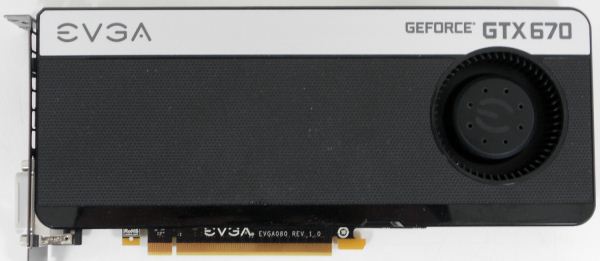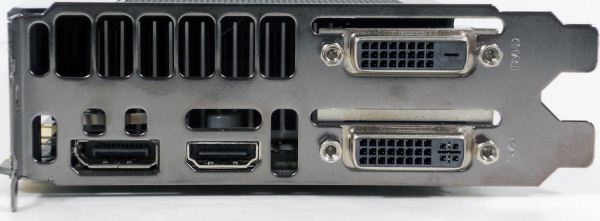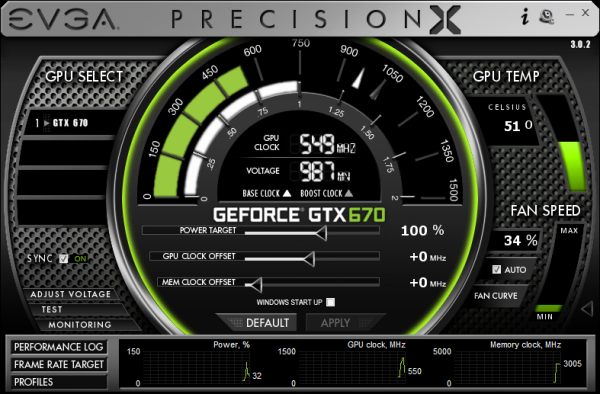NVIDIA GeForce GTX 670 Review Feat. EVGA: Bringing GK104 Down To $400
by Ryan Smith on May 10, 2012 9:00 AM ESTMeet The EVGA GeForce GTX 670 Superclocked
Our second card of the day is EVGA’s GeForce GTX 670 Superclocked, which in EVGA’s hierarchy is their first tier of factory overclocked cards. EVGA is binning GTX 670s and in turn promoting some of them to this tier, which means the GTX 670 Superclocked are equipped with generally better performing chips than the average reference card.
| GeForce GTX 670 Partner Card Specification Comparison | ||||
| EVGA GeForce GTX 670 Superclocked | GeForce GTX 670 (Ref) | |||
| CUDA Cores | 1344 | 1344 | ||
| Texture Units | 112 | 112 | ||
| ROPs | 32 | 32 | ||
| Base Clock | 967MHz | 915MHz | ||
| Boost Clock | 1046MHz | 980MHz | ||
| Memory Clock | 6210MHz | 6008MHz | ||
| Memory Bus Width | 256-bit | 256-bit | ||
| Frame Buffer | 2GB | 2GB | ||
| TDP | 170W | 170W | ||
| Manufacturing Process | TSMC 28nm | TSMC 28nm | ||
| Width | Double Slot | Double Slot | ||
| Length | 9.5" | 9.5" | ||
| Warranty | 3 Years | N/A | ||
| Price Point | $419 | $399 | ||
For the GTX 670 SC, EVGA has given both the core clock and memory clock a moderate boost. The core clock has been increased by 52MHz (6%) to 967MHz base and 66MHz (7%) boost to 1046MHz. Meanwhile the memory clock has been increased by 202MHz (3%) to 6210MHz.
Other than the clockspeed changes, the GTX 670 SC is an almost-reference card utilizing a reference PCB with a slightly modified cooler. EVGA is fabricating their own shroud, but they’ve copied NVIDIA’s reference shroud down to almost the last detail. The only functional difference is that the diameter of the fan intake is about 5mm less, otherwise the only difference is that EVGA has detailed it differently than NVIDIA and used some rounded corners in place of square corners.
The only other change you’ll notice is that EVGA is using their own high flow bracket in place of NVIDIA’s bracket. The high flow bracket cuts away as much metal as possible, maximizing the area of the vents. Though based on our power and temperature readings, this doesn’t seem to have notably impacted the GTX 670 SC.
While we’re on the matter of customized cards and factory overclocks, it’s worth reiterating NVIDIA’s position on factory overclocked cards. Reference and semi-custom cards (that is, cards using the reference PCB) must adhere to NVIDIA’s power target limits. For GTX 670 this is a 141W power target, with a maximum power target of 122% (170W). Fully custom cards with better power delivery circuitry can go higher, but not semi-custom cards. As a result the flexibility in building semi-custom cards comes down to binning. EVGA can bin better chips and use them in cards such as the Superclocked – such as our sample which can go 17 boost bins over the base clock versus 13 bins for our reference GTX 670 – but at the end of the day for stock performance they’re at the mercy of what can be accomplished within 141W/170W.
In any case, as the card is otherwise a reference GTX 670 EVGA is relying on the combination of their factory overclock, their toolset, and their strong reputation for support to carry the card. EVGA has priced the card at $419, $20 over the GTX 670 MSRP, in-line with other factory overclocked cards.
On the subject of pricing and warranties, since this is the first EVGA card we’ve reviewed since April 1st, this is a good time to go over the recent warranty changes EVGA has made.
Starting April 1st, EVGA has implemented what they’re calling their new Global Warranty Policy. Starting July 1st, 2011 (the policy is being backdated), all new EVGA cards ship with at least a 3 year warranty. And for the GTX 600 series specifically, so far EVGA has only offered models with a 3 year warranty in North America, which simplifies their product lineup.
To complement the 3 year warranty and replace the lack of longer term warranties, EVGA is now directly selling 2 and 7 year warranty extensions, for a total of 5 and 10 years respectively. So instead of buying a card with a 3 year warranty or a longer warranty, you’ll simply buy the 3 year card and then buy a warranty extension to go with it. However the extended warranty requires that the card be registered and the warranty purchased within 30 days.
The second change is that the base 3 year warranty no longer requires product registration. EVGA has other ways to entice buyers into registering, but they’ll now honor all applicable cards for 3 years regardless of the registration status. At the same time the base 3 year warranty is now a per-product warranty (e.g. a transferable warranty) rather than per-user warranty, so the base warranty will transfer to 2nd hand buyers. The extended warranties however will not.
The third change is how EVGA is actually going to handle the warranty process. First and foremost, EVGA is now allowing cards to be sent to the nearest EVGA RMA office rather than the office for the region the card was purchased from. For example a buyer moving from Europe to North America can send the card to EVGA’s North American offices rather than sending it overseas.
Finally, EVGA is now doing free cross shipping, alongside their existing Advanced RMA program. EVGA will now cross-ship replacement cards for free to buyers. The buyer meanwhile is responsible for paying to ship the faulty card back and putting up collateral on the new card until EVGA receives the old card.
There’s also one quick change to the step-up program that will impact some customers. With the move to purchasing extended warranties, the step-up program is only available to customers who either purchase an extended warranty or purchase an older generation card that comes with a lifetime warranty. Step-up is not available to cards with only the base 3 year warranty.
Moving on, along with EVGA’s new warranty EVGA is bundling the latest version of their GPU utilities, Precision X and OC Scanner X.
Precision X, as we touched upon quickly in our GTX 680 review, is the latest iteration of EVGA’s Precision overclocking & monitoring utility. It’s still based on RivaTuner and along with adding support for the GTX 600 series features (power targets, framerate caps, etc), it also introduces a new UI. Functionality wise it’s still at the top of the pack along with the similarly RivaTuner powered MSI Afterburner. Personally I’m not a fan of the new UI – circular UIs and sliders aren’t particularly easy to read – but it gets the job done.
OC Scanner X has also received a facelift and functionality upgrade of its own. Along with its basic FurMark-ish stress testing and error checking, it now also offers a basic CPU stress test and GPU benchmark.



















414 Comments
View All Comments
CeriseCogburn - Friday, May 11, 2012 - link
Wasn't caught ? LOL Sounds correct, at least in your mind.Problem is when amd is caught red handed, none of you amd fanboys have a clue about it, ever.
Now I don't have anything against AMD, it's just clear the truth should be told, as I said let's apply the amd fanboy talking points equally, let's do a real analysis and not with instant amnesia that favors amd or ignores the current facts like egg sales.
I have noticed you amd fans have a real hatred for nVidia and all say a similar thing as you just did. It's like poor loser syndrome but I don't think any of you are faking it, I think you are living it in your minds.
That's really sad.
I do believe that's why you can so blindly deny facts and are so often excuse makers and liars for amd and against nVidia quite unfairly. Cut out the hate man. nVidia isn't somehow worse than amd, nor vise versa.
Now I assure you, my post you went into attack mode over above is very simply my on the fly instant analysis by assembling the known facts. It includes principles like what's good for the goose is also fair on the gander, and very simple logic, and some actual original thoughts, etc.
My apologies that I am so excessively astute and can easily see though the amd fud monkey tp, and worse yet, right, show easily the actual nVidia advantage in that very area.
I'm gifted.
SlyNine - Saturday, May 12, 2012 - link
The GTX680 has out sold the 78xx line, interesting, but you need to prove it.CeriseCogburn - Saturday, May 12, 2012 - link
Go to new egg and click on the best selling EVGA GTX680, go to the reviews tab, click the verified buys checkmark, and read the number of verified buyers of the total commenters.That gives you a fair estimate that will be about the same as fair estimates for other products ( it eliminates counting spammers who just have to post without purchasing ).
So just go do that also for the 7870 and 7850 and add up all the totals, and of course include on the 7870 and 7850 and out of stock cards, the "up to 5 eggs" reviews are available for out of stock...
Compare your totals, if you don't know how to navigate new egg efficiently the tip you need is use the "Guided Results" tab on the upper left area once you have clicked into "Desktop Graphics Hardware" from the "shop all stores" yellow upper left start button.
So anyway, 680 was 108 verified a few days ago and all the 7870 and 7850 combined in total were below that by like 30 something - only a single 680 sku was needed, making it easier to collate in the nVidia side.
It should take you all of 3 minutes to verify this right now, and given the level of competence in this post area, here's some helpful starts
http://www.newegg.com/Product/Product.aspx?Item=N8...
680 single sku up to 111 now up from 108
78xx series link access below
http://www.newegg.com/Product/ProductList.aspx?Sub...
There you are, the proof you demanded, once again delivered.
SlyNine - Saturday, May 12, 2012 - link
So that's you're premise for total sales, how many verified buyers there are on neweggs REVIEWS. That's one hella questionable premise and invalid inference of the data available.lmao. Epic fail. Take a logic class
CeriseCogburn - Sunday, May 13, 2012 - link
Yes whine about the data set all you want, but we also have reviewer commentary that is confirming in this, with zero counters by you and yours.Newegg is actually quite an accurate machine for such a thing, best price, best known, most used, and has shown accuracy for a long time in this manner.
Foreigners (non USA) may argue but we don't see any counter arguments now do we mr sad 5870 ? :)
MrSpadge - Thursday, May 10, 2012 - link
You should compare to HD7950 or HD7970 instead of HD6970.. otherwise it's a no brainer ;)chizow - Thursday, May 10, 2012 - link
Certainly a better effort from Nvidia but the premiums are still a product of AMD's overpriced 28nm parts.If AMD priced as they should've from the outset based on historical pricing and relative performance to 40nm parts, we would've seen:
7970 @ $380
7950 @ $300
and Nvidia's parts would've fallen into place accordingly as well:
680 @ $400-$420
670 @ $350
GK110/685 @ $500-$550
GTX 690 @ $700-800
I guess we can't fault Nvidia too much though. In the end they can't keep GK104 in stock anywhere and they still manage to beat AMD convincingly in both price and performance.
The consumer is the one that loses however, paying high premiums for the smallest increase in performance for a full generational/process node improvement.
XZerg - Thursday, May 10, 2012 - link
The price gauging is always a product when the underdog in a market (not necessarily in performance) outdoes the big boss. We saw this happen back when AMD brought out the A64 as well or when ATI released R300 chip. So from consumer's $$$ point of view underdog should stay underdog but deliver performance that matches the big boss.JlHADJOE - Thursday, May 10, 2012 - link
G92 baby!90% of 8800GTX performance at less than half the price.
It was so good, it actually stayed competitive through 3 or 4 product cycles (albeit getting a new sticker every time).
CeriseCogburn - Thursday, May 10, 2012 - link
That's a failed analysis since the price gouging by the same complainers is always present on the flagship models.The true analysis is the honest and common sense one. No matter what anyone's twisted brain calls the competers, when any one in competition throws up a leader board item, they charge for it.
What's shameful in amd's case is the very quick slap down they experienced - smacking $579.99 down to $449.99(or 479) then the second whallop sending them to the deck, the 3 games they offered to attempt to keep interest going, and now another knockout punch square to the drooling amd choppers as they wobbled on noodle legs still getting the former ten count - the GTX670 tag team card with the new smack down....
I suspect amd will try to maintain some sort of composure and self esteem this time by not budging as long as they possibly can... because it's embarrassing already and now the GTX670 has turned amd from bright pink to their standard red color - flush to the point of passing out.
Yes, amd will pretend now - pretend it doesn't have to drop prices again.